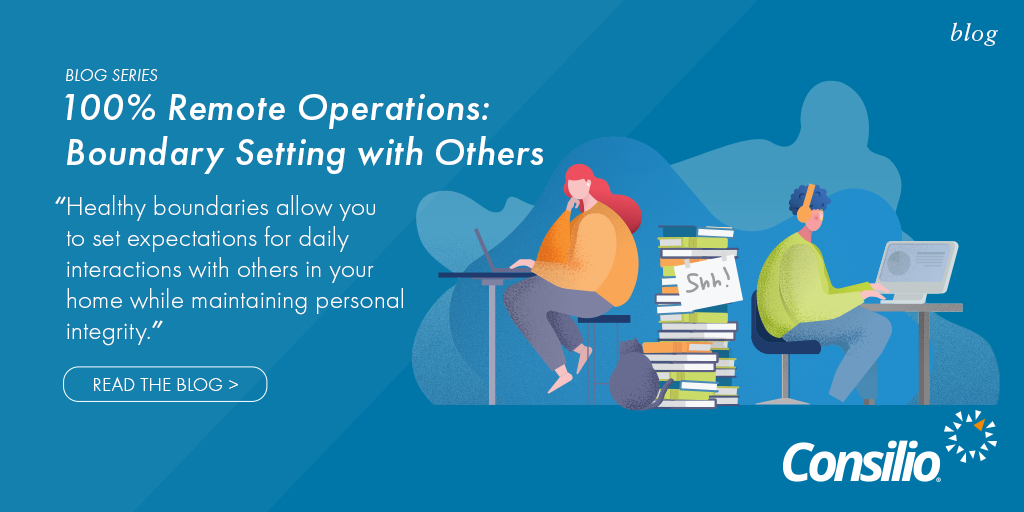This blog is part of our 100% Remote Operations: Working From Home series.
Households all over the world have been following shelter-in-place orders for more or less than one month now. For many, the new reality of being home 24/7 has included navigating the waters of boundary-setting. Outside of the office, whether you are isolating with kids, a significant other, roommates, or anyone else, setting boundaries helps ensure that you can accomplish your own goals while not stepping on others’ toes.
 There are several advantages to setting boundaries:
There are several advantages to setting boundaries:
- Good mental health
- Good emotional health
- Developed autonomy
- Developed identity
- Avoidance of burnout
- Influence others’ behavior
Boundaries allow you to set expectations for daily interactions with others in your home while maintaining personal integrity. Respect is at the core of boundary-setting; however, according to Psychology Today, most people are not aware that they have invaded your space if or when they do. With this in mind, boundary-setting must be a two-sided process with understanding from all parties involved. In this blog, we discuss ways to foster continuous dialogue that results in consensus and clear communication from all sides.
Consider What Is Necessary For You
In our Boundary-Setting For Yourself blog, we discussed actions you can take to create healthy boundaries between professional and personal life while working at home. A common theme throughout the article was the need for mental preparation involved in the process. Setting boundaries with others compounds upon the mental preparation process.
Starting out, make note of what is most important to you. For example, you may feel that you are most productive if you have 30 minutes of uninterrupted meditation before you begin working every day. This is where your boundary-setting begins. If you decide that it is imperative to have this 30-minute window of meditation every day, communicating this to others in your household becomes a must. Without this communication, they may not be aware of the importance of meditating to you, or even how you use this window of time in the first place.
However, before discussing with others in your household, you may want to brainstorm your ideal boundaries and write them down on paper. You may find that some of your points are more important than others. With this in mind, you can enter the discussion anticipating flexibility and compromise.
Voice Your Thoughts
When discussing sensitive issues, there are several rules to be followed. Often, the process of boundary-setting can contentious, but there are ways to make the dialogue flow easier.
- Keep an open mind. As discussions are not one-sided, participants should be open to hearing potential solutions and input from everyone involved.
- Actively listen. To ensure that the conversation is fair and productive, it is best to make sure no one is being talked over and that everyone is being heard.
- Stick to the agenda. Staying on topic means that there will be more precision when discussing what you want. Stay on track by keeping your message simple without overexplaining.
- Explain importance. To others, it may be unclear why you are setting boundaries in certain situations. Explaining the significance of the boundaries gives better clarity and insight to those around you.
Personal Accountability
Of course, coexisting involves accommodating and respecting the needs of others living in your house alongside you. As mentioned before, leaving room for flexibility and compromise is essential for healthy boundary-setting. If someone in your house needs to use the printer located in your working space at 10 am, but you have requested to have zero interruptions every day from 8 am to 11 am, a reasonable exception can be made.
However, it is also necessary to understand that adjusting to boundaries can take some getting used to. Here, you must be firm and consistent with your message, as whatever you say goes. How you communicate and enforce your boundaries can set you up for success in the future. The initial adjustment to boundaries can be uncomfortable for those around you, but will eventually become a new, healthy normal.
“In my usual work from home situation the work from home boundaries are nicely set. My wife also works from home, but upstairs — so there is a nice separation, especially for conference calls. The kids are usually in school but it is a little harder to navigate with having them directly outside my office and nowhere to go. I appreciate getting to see them during the day but makes it harder to enforce “office hours”, which is easier to explain to my wife than three and four-year-olds!”
Jacob Lazinger, Business Development Manager
Continuous Open Dialogue
With everyone staying home these days, there are more opportunities for stepping on others’ toes. In order to avoid confusion and conflict, boundary-setting with others is key. Although the process can feel tedious, it is a hugely important part of paving the way for future success. As important as it is to set your boundaries for home-working, it is equally important to abide by the boundaries others have set as well. As always, things change, and situations develop, but continuous open dialogue will promote solution-based approaches. With clear dialogue, there will be less confusion and violation of boundaries.